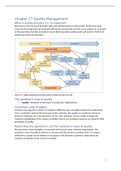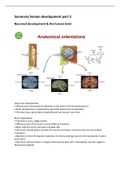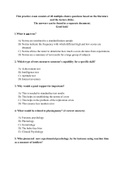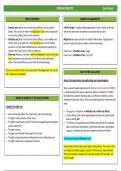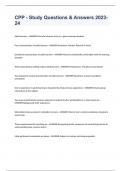ANIMAL MODELS
− 3Rs:
o replacement = any scientific method employing non-sentient material which may replace
methods which use conscious living vertebrates
o reduction = lowering the number of animals used to obtain information of a given amount
and precision
o refinement = set of measures undertaken to decrease in the incidence or severity of
procedures applied to those animals which have to be used
− why animal models:
o research with animals has contributed to more than half of the significant discoveries
o the complexity of living organisms at some point requires research and testing on animals
o unforeseen side effects of inadequately tested new drugs or biomedical materials have
proven the need for extensive animal tests before they can meet FDA/EMA registration
requirements for human application
− laboratory animal model = ‘an animal model in which normative biology or behaviour can be
studied or in which a spontaneous or induced pathological process can be investigated, and in which
the phenomenon in one or more aspects resembles the same phenomenon in humans or other
species of animal’
− disease models: induced (experimental), spontaneous (genetic), and transgenic disease models
− neutral models: healthy animals from all species for physiology research
INBRED/ISOGENIC STRAINS
− produced by many generations of brother and sister mating
− genetic homogeneity → phenotypic uniformity
− genotype doesn’t influence the results
− the same genotype can be reproduced indefinitely, but there may be some genetic drift over time
due to the accumulation of new mutations
− smaller numbers of animals needed to achieve a given level of statistical precision → higher
statistical reproducibility
− weaker due to more homozygosity
− more stable, uniform, and repeatable in most toxicity testing → using different strains in a factorial
experimental design without increasing the total number of animals for toxicology experiments
− more sensitive to experimental treatments → increased power of experiments
− internationally distributed → work can be replicated all over the world
− searchable list of inbred strains of mice and rats and their characteristics
− diversity outbreeds:
o outbreeding can be done between different strains to partially predict the genetic outcome
o evaluating fundamental or undefined processes → reproduction, physiology, toxicology
o investigation of the genetic and environmental basis of disease
o experiments can be repeated with similar genetic composition between animals
o no genetic difference between controls and experimental animals → large size groups
,OUTBRED STRAINS
− breeding colonies in which there is (certain) degree of genetic variation
− genetically diverse population
− nothing is known about the genotype of any individual and no two individuals are alike
− control and treated animal differ both in treatment and in genotype to an unknown extent
− larger sample sizes
− scientists justify their use on the grounds that the aim is to model humans who are genetically
variable, but this is not consistent since there is still uniform housing, feed, bedding, etc.
− used to model physiology and reproduction
TYPE of MODEL
− scientific preparation → consultation of literature and experts
− choices based on best not common practice
− species, life stage, genetic modifications…
− ‘lowest’ species possible without compromising the study outcomes
− physiology and anatomy characteristics and similarity to humans
− new models are continuously identified and characterized
− not based solely on availability, familiarity, or cost → may not provide genetic, physiologic,
psychological facts needed or wanted for the project
− highly specific to a particular study
− mice and rats:
o ideal for mammalian genetics
o small and easy to maintain
o great reproductive performance
o similar anatomy and physiology
o genetics can be manipulated in ways not possible with humans → more valuable as models
of humans for some applications
− model validation:
o face validity = resemblance in symptoms and signs, most important one
o predictive validity = resemblance in reaction to current treatment
o construct validity = resemblance in origin/mechanism
− forced swim test:
o model for depression in humans
o response to lithium dosage
o big discomfort
o the model is being abandoned
− Dutch law:
o obtained by breeding
o buying from an accepted (licensed) supplier (continually refreshed stock)
o exemptions: pigeons, goats, turkeys, chickens, horses, cows, sheep, pigs, and fish
− C57BL/6 mice (B6, black mice):
o high health status
o well characterized
, o most published
o extensive phenotypic data
o consistent data reproducibility
o minimizing genetic drift (inbreeding), known which substrain is needed for certain research,
learn to use proper nomenclature
− genetic drift:
o constant tendency of genes to evolve even in the absence of selective forces
o fuelled by spontaneous neutral mutations that disappear or become fixed in a population at
random
o single base changes, deletions, duplications, inversions in the DNA
o colonies separated by 20 or more generations → phenotypic or genetic differences
o minimizing: pedigree lines and detailed colony records, watch for phenotypic changes in
mutants and controls, refreshing breeders frequently, avoiding selection pressure, verify
genetic background with genome scanning, cryopreserve unique strains
− differences:
o there are some differences between the model and the target otherwise the model wouldn’t
be the model
o the similarity between man and animal model could just be on 1 aspect of the process
studied to make it a useful model
LEGISLATION – EXPERIMENTS on ANIMALS ACT
LAW & REGULATIONS
− intent:
o starting point → protection of the animal
o Article 1: intrinsic value of the animal based on the fact that animals can suffer, no-unless
principle (3R-principle for alternatives)
− history:
o discovering anatomy, physiology, and pathology of both animals and humans
o 1977. Dutch Experiments on Animals Act → 1st legislation on animal experiments
o 1992. Health and Welfare Law for Animals → more insight on animal housing and welfare
regulations
o 1996. Major Revision of Experiments on Animals Act
o 2013. Law animals
o 2014. revised experiments on animals act → following a European directive since Dutch law
was much stricter
o directive 2010/63/EU → coherence over EU in animal treatment in laboratories,
implementing 3Rs, improving welfare, transparency, and enforcement
− Experiments on Animals Act:
o Experiments on Animals Decree → Experiments on Animals Regulation
o more easily changed than the law
o describe how the law should be implemented
, − 2010/63/EU directive:
o Annexes I-VI within the directive (more detailed)
o guidance documents (don’t have full status of a law)
− other relevant laws:
o Law of Nature preservation = protection of species in the wild, licence for field work
needed, relevant for animal experiments in the wild and capturing animals in the wild
o Law on Animals: transport, weaning, mutilation (dehorning, toe clipping), housing
o Law on Environmental Pollution = working with GMOs → making sure these animals don’t
escape into nature
− no legal base on education and training
ANIMAL EXPERIMENT
− 3 requirements:
o species – animals that are able to suffer (vertebrate animals, certain squids), life stages –
excluding embryos unless it has an effect on an animal in a later stage, 3rd part of a
pregnancy in mammals, or from the stage when the fetus is able to feed itself
o goal of the procedure → acquiring or sharing knowledge
o animal actually suffers from the experiment → needle insertion (according to a good
veterinarian practice) is the lowest threshold
− animal experiment = any use, invasive or non-invasive, of an animal for experimental or other
scientific purposes, with known or unknown outcome, or educational purposes, which may cause
the animal a level of pain, suffering, distress, or lasting harm equivalent to, or higher than, that
caused by the introduction of a needle in accordance with good veterinary practice
− restriction: not allowed to conduct animal experiments if the 3Rs are not met (Article 1)
− Dutch addition: killing of animals solely for the use of their organs or tissues → under the Dutch
Experiments on Animal Acts this is an animal experiment (requires project authorization)
INVOLVED PARTIES, PROCEDURE & CONTROL
− nationally:
o Ministry of Agriculture (NVWA, NCaD)
o CA/CCD: competent authority, final ethical judgement, issues project licenses
o NVWA: Netherlands Food and Safety Authority, issues institutional license (needed to apply
for a project license), external supervision on institutions, yearly registration of all animal
experiments
o NCad: advice to the minister, CCD, AWBs, making sure best practices are dispersed
o applicant requirements (Article 9 qualified persons): MSc with 500 hours education in basic
biology, LAS course, and species-specific knowledge
o application:
▪ non-technical summary – publicly available
▪ project proposal – background, goal, importance, research strategy
▪ appendices – type of procedure, number of animals, discomfort, HEP, should be
detailed enough for ethical judgement
o final application sent to CCD after being signed by NVWA
− 3Rs:
o replacement = any scientific method employing non-sentient material which may replace
methods which use conscious living vertebrates
o reduction = lowering the number of animals used to obtain information of a given amount
and precision
o refinement = set of measures undertaken to decrease in the incidence or severity of
procedures applied to those animals which have to be used
− why animal models:
o research with animals has contributed to more than half of the significant discoveries
o the complexity of living organisms at some point requires research and testing on animals
o unforeseen side effects of inadequately tested new drugs or biomedical materials have
proven the need for extensive animal tests before they can meet FDA/EMA registration
requirements for human application
− laboratory animal model = ‘an animal model in which normative biology or behaviour can be
studied or in which a spontaneous or induced pathological process can be investigated, and in which
the phenomenon in one or more aspects resembles the same phenomenon in humans or other
species of animal’
− disease models: induced (experimental), spontaneous (genetic), and transgenic disease models
− neutral models: healthy animals from all species for physiology research
INBRED/ISOGENIC STRAINS
− produced by many generations of brother and sister mating
− genetic homogeneity → phenotypic uniformity
− genotype doesn’t influence the results
− the same genotype can be reproduced indefinitely, but there may be some genetic drift over time
due to the accumulation of new mutations
− smaller numbers of animals needed to achieve a given level of statistical precision → higher
statistical reproducibility
− weaker due to more homozygosity
− more stable, uniform, and repeatable in most toxicity testing → using different strains in a factorial
experimental design without increasing the total number of animals for toxicology experiments
− more sensitive to experimental treatments → increased power of experiments
− internationally distributed → work can be replicated all over the world
− searchable list of inbred strains of mice and rats and their characteristics
− diversity outbreeds:
o outbreeding can be done between different strains to partially predict the genetic outcome
o evaluating fundamental or undefined processes → reproduction, physiology, toxicology
o investigation of the genetic and environmental basis of disease
o experiments can be repeated with similar genetic composition between animals
o no genetic difference between controls and experimental animals → large size groups
,OUTBRED STRAINS
− breeding colonies in which there is (certain) degree of genetic variation
− genetically diverse population
− nothing is known about the genotype of any individual and no two individuals are alike
− control and treated animal differ both in treatment and in genotype to an unknown extent
− larger sample sizes
− scientists justify their use on the grounds that the aim is to model humans who are genetically
variable, but this is not consistent since there is still uniform housing, feed, bedding, etc.
− used to model physiology and reproduction
TYPE of MODEL
− scientific preparation → consultation of literature and experts
− choices based on best not common practice
− species, life stage, genetic modifications…
− ‘lowest’ species possible without compromising the study outcomes
− physiology and anatomy characteristics and similarity to humans
− new models are continuously identified and characterized
− not based solely on availability, familiarity, or cost → may not provide genetic, physiologic,
psychological facts needed or wanted for the project
− highly specific to a particular study
− mice and rats:
o ideal for mammalian genetics
o small and easy to maintain
o great reproductive performance
o similar anatomy and physiology
o genetics can be manipulated in ways not possible with humans → more valuable as models
of humans for some applications
− model validation:
o face validity = resemblance in symptoms and signs, most important one
o predictive validity = resemblance in reaction to current treatment
o construct validity = resemblance in origin/mechanism
− forced swim test:
o model for depression in humans
o response to lithium dosage
o big discomfort
o the model is being abandoned
− Dutch law:
o obtained by breeding
o buying from an accepted (licensed) supplier (continually refreshed stock)
o exemptions: pigeons, goats, turkeys, chickens, horses, cows, sheep, pigs, and fish
− C57BL/6 mice (B6, black mice):
o high health status
o well characterized
, o most published
o extensive phenotypic data
o consistent data reproducibility
o minimizing genetic drift (inbreeding), known which substrain is needed for certain research,
learn to use proper nomenclature
− genetic drift:
o constant tendency of genes to evolve even in the absence of selective forces
o fuelled by spontaneous neutral mutations that disappear or become fixed in a population at
random
o single base changes, deletions, duplications, inversions in the DNA
o colonies separated by 20 or more generations → phenotypic or genetic differences
o minimizing: pedigree lines and detailed colony records, watch for phenotypic changes in
mutants and controls, refreshing breeders frequently, avoiding selection pressure, verify
genetic background with genome scanning, cryopreserve unique strains
− differences:
o there are some differences between the model and the target otherwise the model wouldn’t
be the model
o the similarity between man and animal model could just be on 1 aspect of the process
studied to make it a useful model
LEGISLATION – EXPERIMENTS on ANIMALS ACT
LAW & REGULATIONS
− intent:
o starting point → protection of the animal
o Article 1: intrinsic value of the animal based on the fact that animals can suffer, no-unless
principle (3R-principle for alternatives)
− history:
o discovering anatomy, physiology, and pathology of both animals and humans
o 1977. Dutch Experiments on Animals Act → 1st legislation on animal experiments
o 1992. Health and Welfare Law for Animals → more insight on animal housing and welfare
regulations
o 1996. Major Revision of Experiments on Animals Act
o 2013. Law animals
o 2014. revised experiments on animals act → following a European directive since Dutch law
was much stricter
o directive 2010/63/EU → coherence over EU in animal treatment in laboratories,
implementing 3Rs, improving welfare, transparency, and enforcement
− Experiments on Animals Act:
o Experiments on Animals Decree → Experiments on Animals Regulation
o more easily changed than the law
o describe how the law should be implemented
, − 2010/63/EU directive:
o Annexes I-VI within the directive (more detailed)
o guidance documents (don’t have full status of a law)
− other relevant laws:
o Law of Nature preservation = protection of species in the wild, licence for field work
needed, relevant for animal experiments in the wild and capturing animals in the wild
o Law on Animals: transport, weaning, mutilation (dehorning, toe clipping), housing
o Law on Environmental Pollution = working with GMOs → making sure these animals don’t
escape into nature
− no legal base on education and training
ANIMAL EXPERIMENT
− 3 requirements:
o species – animals that are able to suffer (vertebrate animals, certain squids), life stages –
excluding embryos unless it has an effect on an animal in a later stage, 3rd part of a
pregnancy in mammals, or from the stage when the fetus is able to feed itself
o goal of the procedure → acquiring or sharing knowledge
o animal actually suffers from the experiment → needle insertion (according to a good
veterinarian practice) is the lowest threshold
− animal experiment = any use, invasive or non-invasive, of an animal for experimental or other
scientific purposes, with known or unknown outcome, or educational purposes, which may cause
the animal a level of pain, suffering, distress, or lasting harm equivalent to, or higher than, that
caused by the introduction of a needle in accordance with good veterinary practice
− restriction: not allowed to conduct animal experiments if the 3Rs are not met (Article 1)
− Dutch addition: killing of animals solely for the use of their organs or tissues → under the Dutch
Experiments on Animal Acts this is an animal experiment (requires project authorization)
INVOLVED PARTIES, PROCEDURE & CONTROL
− nationally:
o Ministry of Agriculture (NVWA, NCaD)
o CA/CCD: competent authority, final ethical judgement, issues project licenses
o NVWA: Netherlands Food and Safety Authority, issues institutional license (needed to apply
for a project license), external supervision on institutions, yearly registration of all animal
experiments
o NCad: advice to the minister, CCD, AWBs, making sure best practices are dispersed
o applicant requirements (Article 9 qualified persons): MSc with 500 hours education in basic
biology, LAS course, and species-specific knowledge
o application:
▪ non-technical summary – publicly available
▪ project proposal – background, goal, importance, research strategy
▪ appendices – type of procedure, number of animals, discomfort, HEP, should be
detailed enough for ethical judgement
o final application sent to CCD after being signed by NVWA


